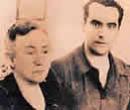Federico Garcia Lorca
On June 25, 1929, Lorca arrived in New York, after staying some months in the big city, which inspired him to write his book Poeta en Nueva York (Poet in New York) and when he was thinking to return to his homeland, he was invited to Cuba by Fernando Ortiz, a Cuban prolific writer on several subjects who presided over the institution named Hispanocubana de Cultura.
His visit, scheduled for a couple of days, just to deliver some lectures in the Cuban capital, extended to near three months¾from March 7 to June 12, 1930¾during which he toured the island and left an imprint of admiration and of legend in every corner he visited and perhaps that was the reason for which novelist Lino Novás Calvo stated in 1940 that "here every Cuban has his Lorca."
Arrival in Cuba "...the boat is getting farther and farther and the smell of palm and cinnamon start surrounding the space, the perfumes of the Americas with their roots, the Americas of God. But what is this? Spain, again? Again, the Andalusia of the world? It is the yellow color of Cadiz with a more intense shade, the rose of Seville almost red and the green of Granada with a light fish-like phosphorescence.
"Havana rises over sugar cane plantations, the sound of maracas, divine bugles and marimbas. And who welcomes me in the port? Trinidad, the black woman of my childhood, that one that used to ride along Havana dock. And the blacks with the rhythms that I discovered as typical of my great Andalusian people, negritos without despair that states with pride: 'We are Latin.'"
With these suggestive images Lorca evoked his arrival in Havana, during the reading of a poetry that he performed in Madrid shortly after his return.
The Best Days of His Life When leaving Cuba, the Andalusian poet stated to his friends: "Here I have spent the best days of my life," an opinion that was then ratified by his mother, Doña Vicenta Lorca, who in September of that same year wrote a letter to María Muñoz stating that his son "speaks with such an enthusiasm on Cuba that I think he likes it more than his own land."
The reasons by which that Cuban spring became the poet's merriest days are many and varied. Here he found a propitious cultural milieu, his passionate spirit expanded and released his personal charisma, free of any type of pressure or conventionalism. He was admired by the "distinguished ladies of the society of Havana" and fully enjoyed with special pleasure the cup of coffee offered by "an immense and nice black woman" living in a type of phalanstery (community dwellings) of Havana. He himself declared to have participated in an exciting crocodile hunting at Ciénaga de Zapata, a site abundant of any sort of animals."
To that first image of color and cheerful noise seen aboard the boat while approaching Cuba, were added the enjoyment of Varadero Beach with the passing days, the observation and ecstasies at the sight of the particular landscapes of Viñales Valley and the unexpected shades of a twilight at Yumurí Valley and then his trip to Santiago de Cuba, portrayed in his son "I'll go to Santiago" where he regards the island as a "harp of live trunks" because when passing by its arch formed by palm trees, he was left with the vision that a giant harp was waiting for a huge hand that played some symphony.
He frequently visited the large house of the Loynaz at Vedado. He enjoyed there long and amusing gatherings from where he told interesting anecdotes. He established friendly links with the best of the Cuban intelligentsia, he got acquainted with the aristocracy of Havana and with people of disorderly life he met at cheap bars and night clubs. In the street food points where fritters were sold at Marianao (a municipality of Havana City) in the company of young and old soneros, he started his knowledge on son, the ardent Cuban rhythm which he and his friend Adolfo Salazar made known shortly after in Granada and Madrid.
Lorca's Love in Cuba Salazar, the musicologist, who was visiting Havana at the same time as Lorca, said that the poet has fallen in love with a mulatto girl that was modeling for a painter during daylight and run a cheap establishment of prepared food for sale in the evening, but nothing is known on the identity and the adventures of this love match. It is irrefutable that Lorca was much impressed by the beauty of the Cuban mulatto woman. In a letter written to his parents from Havana, he stated: "The mulatto woman here is by far superior in beauty, distinction and gentleness...." The allege romance in Havana between García Lorca and the Colombian poet, Porfirio Barba Jacob, who was also in Cuba at that time, was questioned by Cardoza y Aragón, consul of Guatemala to Havana at that date when he stated: "I, who coincided with both poets, I wouldn't dare to state so categorically. Federico felt certain aversion for Barba, he rejected him. Perhaps the Colombian poet...boasted an intimate relation with Federico, spreading this unfortunate misinterpretation that has been passed until today...but I believe that this friendship has hardly any probability to exist."
A Bright Imprint If Cuba impressed the immortal son of Granada and provided with life experiences and emotions unknown to him until that segment of his life, also Lorca impressed Cuba. His versatile and deep work and his personal charm of a poet were planting seeds of light and love along his path over the island and that is why 75 years after his death, people still think of Federico as a known beloved acquaintance. So it is right to pose the question: Which memories left Federico García Lorca in Cuba? The answer is: He didn't leave any memories, but the energy of his personality, his spirit. He's a life presence!




































































